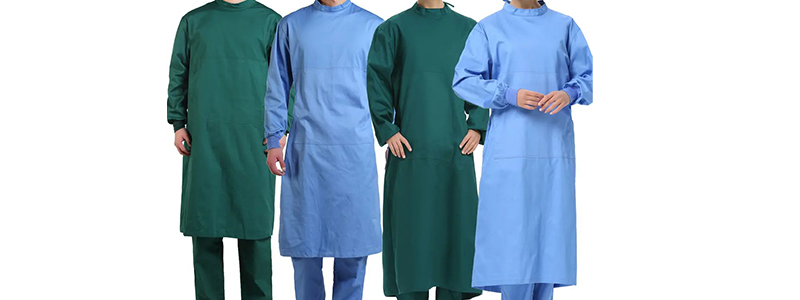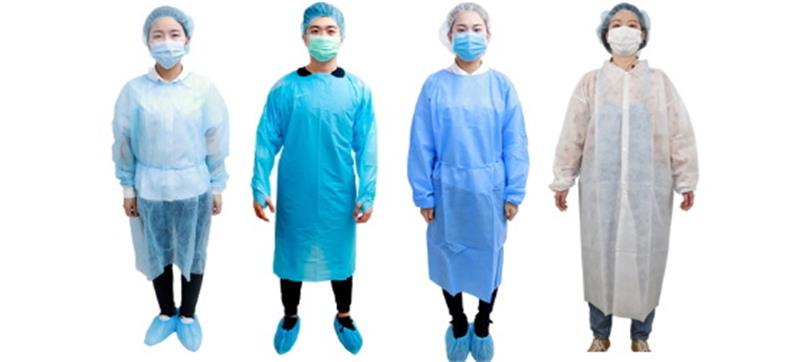In healthcare, Medical gowns play a pivotal role, ensuring both patient and doctor comfort and medical efficiency. This guide introduces the top 5 types of Medical gowns. Each Medical gown serves a unique purpose in the intricate dance of healthcare protocols, from the sterile surgical gowns to the protective shield of isolation gowns.
Surgical Gown
Surgical gowns, essential components of the medical attire ensemble, are meticulously designed with diverse features to ensure optimal protection and functionality in healthcare settings. The substrate, typically crafted from non-woven or woven fabric, combines with a water-resistant layer to create a formidable defense against contaminants.
These gowns manifest in two primary supply forms: sterile, for one-time use, and non-sterile, suitable for reusability.

Barrier Capabilities:
Surgical gowns serve as a frontline defense, strategically preventing the dispersion of skin flakes from medical personnel onto open surgical wounds and impeding the transmission of bodily fluids from patients to healthcare providers. They, thus, play a pivotal role in facilitating bidirectional biological protection.
Anticipated Applications:
Tailored for surgical and invasive procedures, disposable surgical gowns aim to prevent the transmission of infectious agents between patients and healthcare practitioners. High-performance surgical gowns, designated for urgent scenarios involving known or unknown infectious agents in the blood, cater to diverse medical requirements.

Performance Standards:
In adherence to YY0506.8-2019 regulations, the neck and waist ties of surgical gowns should withstand a 10N axial static pulling force for one minute without breakage or detachment. Moreover, these gowns are categorized into four levels based on their protective performance, denoted as AAMI level 1 to AAMI level 4. A higher numerical value indicates enhanced protective capabilities.
Enhanced Protection:
Sterile surgical gowns, paramount in minimizing the transmission of contaminants to patients’ surgical wounds, prove invaluable in preventing postoperative infections. The use of surgical gowns with fluid-resistant properties significantly reduces the risk of healthcare personnel carrying infectious microorganisms present in blood or bodily fluids.
Isolation Gown
Isolation gowns, integral components of protective attire in healthcare, play a pivotal role in safeguarding medical personnel, visitors, and patients from potential contamination by body fluids.
Material Expertise:
Crafted from specialized materials, isolation gowns serve as formidable barriers against body fluids, including but not limited to blood, semen, vaginal secretions, cerebrospinal fluid, synovial fluid, peritoneal fluid, amniotic fluid, and saliva. The material composition, often non-woven fabrics like SMS or SPES, strikes a delicate balance between impermeability and breathability.

Disposable and Reusable Options:
Isolation gowns are available in both disposable and reusable forms. Reusable gowns, recommended for routine use in hospitals, now feature lightweight, breathable designs aligned with international trends. Following stringent cleaning and disinfection procedures, these gowns offer a sustainable alternative to their single-use counterparts, as per the manufacturer’s guidelines.
Application Scenarios:
The utilization of isolation gowns is paramount in scenarios involving contact transmission of infectious diseases or when in close proximity (within 1 meter) to patients with respiratory infections. In environments demanding heightened protection, such as bone marrow transplant units or critical care settings, sterile isolation gowns become imperative for comprehensive protection.
Fluid Resistance Standards:
In adherence to ASTM F3352-19 standards, isolation gowns must provide “360° coverage,” ensuring complete protection for the arms and front, sides, and back of the body from knees to neck (excluding the neck). Notably, the design focuses on safeguarding the lower body, and not the entire body from head to toe.

Design Conformity:
The design of medical isolation gowns must adhere to ANSI/AAMI PB70 requirements for barrier performance. Critical areas, including seams but excluding cuffs, hems, and bindings, should exhibit a minimum barrier performance level of 1. The sizing and design should ensure 360° coverage, encompassing the arms and the front, sides, and back of the body from knees to neck during movement.
Reusable Gown Monitoring:
For reusable isolation gowns, manufacturers must incorporate a device or designated area allowing users to record or mark the number of reuse cycles. This ensures transparency and accountability in monitoring the gown’s lifespan.
In conclusion, isolation gowns serve as indispensable elements in infection control within medical settings. Their meticulous design, material selection, and adherence to industry standards collectively contribute to creating a robust defense against the transmission of infectious agents, reinforcing the safety of healthcare professionals and those under their care.
Patient Gown
Patient gowns, also known as hospital gowns or patient wear, are a fundamental component of hospital attire designed explicitly for individuals undergoing medical treatment and care during their hospital stay. This segment delves into the key facets of patient gowns, highlighting the pivotal aspects that contribute to their effectiveness and user satisfaction.

Specialized Designs for Diverse Needs:
Patient gowns cater to a spectrum of healthcare requirements, encompassing specialized designs such as those tailored for orthopedic patients, maternity wear for expectant mothers, and sets featuring separate ensembles for men and women. These variations address the unique needs of different patient demographics, ensuring both comfort and functionality.
Fabric Variety:
Patient gowns come in diverse fabric options, including pure cotton variants renowned for their breathability and comfort. The use of color-woven fabrics adds an aesthetic element to the attire. Additionally, gowns crafted from materials resistant to frequent washing contribute to extended durability, meeting the rigorous demands of hospital environments.
Comprehensive Coverage:
Available in long-sleeved, short-sleeved, and pant variants, patient gowns offer comprehensive coverage tailored to the specific treatment or medical procedure. The selection of the appropriate gown style is crucial, aligning with the nature of the medical intervention and the patient’s comfort.
Humanized Design Elements:
A paramount consideration in patient gown selection revolves around humanized design elements. These encompass features that enhance the overall experience for the wearer, such as easy accessibility for medical procedures, convenient fastening mechanisms, and designs that prioritize the patient’s dignity and modesty.
Practical Considerations for Inpatient Comfort:
Patient gowns play a vital role in ensuring the comfort of inpatients. The design should take into account factors such as ease of wear, flexibility for movement, and suitability for various body types. This practical approach contributes to a positive and comfortable experience for individuals navigating their treatment journey within the hospital setting.
In essence, patient gowns transcend their utilitarian purpose, evolving into garments that amalgamate functionality with thoughtful design. By addressing the diverse needs of patients and incorporating human-centric elements, these gowns become not just attire but integral contributors to the overall well-being and satisfaction of individuals undergoing medical care.
Nurse Uniform (Nursing Scrubs)
The journey of nurse uniforms has witnessed a significant transformation, not only in design but also in the diverse palette of colors employed. This section unravels the narrative of nurse uniforms, exploring the evolution of colors and their profound implications in different healthcare settings.

Historical Transition:
From the early ensemble of hats, dresses, and aprons, nurse uniforms underwent a substantial transition in the 1960s when modern nurse uniforms became a mandate in China. This transition marked a shift from predominantly white uniforms to a spectrum of colors, catering to the specific needs of various medical departments.
Serenity in White:
White remains the most prevalent color in nurse uniforms, finding widespread application across various hospital departments. Renowned for its calming and clean attributes, white evokes a sense of reassurance and professionalism. The visibility of dust on white uniforms also reflects the hospital’s commitment to hygiene, fostering trust among patients.
Pink for Compassion:
Pink-hued nurse uniforms are commonly associated with departments like obstetrics and pediatrics. In color psychology, red hues convey warmth, hope, and innocence. Nurses clad in pink can subtly communicate a soothing atmosphere, especially crucial when caring for infants, as the color aids in establishing a comforting connection.

Professionalism in White – A Higher Calling:
White nurse uniforms often grace departments dealing with intense medical interventions, such as pain management or ophthalmology. The demanding nature of these roles often translates into higher salaries for nurses wearing white, reflecting the increased responsibilities and workload they shoulder.
Beyond White and Pink:
Beyond the traditional white and pink, nurse uniforms come in a spectrum of colors catering to specific medical environments. Green uniforms, prevalent in emergency rooms, operating theaters, and intensive care units, serve to alleviate patient anxiety and symbolize vitality. Purple uniforms in the ICU exude luxury and femininity, offering a calming effect on patients.
Soothing Hues for the Elderly:
Light blue nurse uniforms, commonly found in private hospitals’ geriatric departments, belong to the cool color spectrum. These hues, with their youthful charm, effectively alleviate tension and anxiety among elderly patients, aiding in their adaptation to the hospital environment.
The evolution of nurse uniforms reflects a thoughtful blend of aesthetics and functionality. The choice of colors goes beyond mere aesthetics, playing a pivotal role in shaping the atmosphere, comforting patients, and enhancing the overall healthcare experience.
White Lab Coat
The white lab coat, a ubiquitous symbol in the realms of hospitals, clinics, pharmaceuticals, biotechnology, laboratories, and beauty salons, stands as a frontline defense for healthcare professionals. Beyond its visual significance, this quintessential garment plays a pivotal role in maintaining hygiene, providing protection against electrostatic discharge, and influencing the emotional well-being of patients.

Industry Versatility:
Adaptable to various professional settings, the white lab coat finds its place in the diverse landscapes of healthcare, research, and beauty industries. Its universal presence signifies a commitment to cleanliness, professionalism, and adherence to safety protocols.
Psychological Impact:
Research suggests that the color of a medical professional’s attire has a psychological impact on patients and their families. The pristine white of the lab coat has a calming effect, fostering an environment of trust and reassurance. It symbolizes purity, instilling confidence in the capabilities and expertise of the wearer.
Functional Fabrics:
Crafted from high-quality functional fabrics, the white lab coat boasts superior antibacterial properties, breathability, excellent moisture absorption, soft comfort, slight elasticity, and a non-restrictive fit. These fabrics ensure that healthcare professionals can move seamlessly while maintaining a sterile and protective environment.

Multifaceted Benefits:
The white lab coat serves as a multi-dimensional tool:
Warning Function: Its presence warns against environmental contamination and safety hazards, promoting a clean and organized laboratory or clinical space.
Enhanced Attention to Detail: Professionals become more cautious, preventing accidental spills or mishandling of equipment due to the desire to keep the lab coat spotless.
Professional Image: Projecting an image of seriousness, responsibility, and precision, the lab coat contributes to a professional demeanor.
Skin Protection: Offering an additional layer of defense, the lab coat minimizes potential harm from accidental exposure to pharmaceuticals or hazardous substances.
Reduced Hidden Risks: Visible contamination on the white lab coat serves as a visual cue, allowing for immediate detection and elimination of potential risks to both researchers and the surrounding environment.
Color Contrast Utility: The white lab coat’s neutral background enhances color contrast, aiding researchers in distinguishing the hues of various substances.
Anti-Static Properties: A quality white lab coat effectively mitigates static electricity, ensuring a safe working environment, particularly in laboratories where sensitive electronic equipment is present.
In essence, the white lab coat transcends its role as mere attire; it becomes an emblem of professionalism, responsibility, and a commitment to maintaining a hygienic and safe environment within the diverse spheres of healthcare and research.






